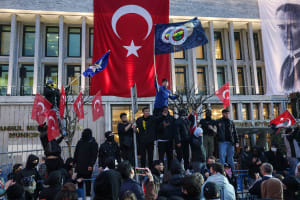Not just in Gaza: After Sinwar’s death, Hamas branches across Middle East are gaining importance
Destroying Hamas infrastructure in Gaza will not be enough to destroy the organization

With the death of Hamas leader Yahya Sinwar and the advancing destruction of Hamas’ formerly unchallenged stronghold in the Gaza Strip, the terror group’s lesser-known international headquarters are likely to gain new significance, with one of them possibly becoming its future central headquarters.
Since taking power from the Fatah party in a violent coup in 2007, Hamas has made the Gaza Strip its most important base, building up a huge, well-armed terror army and many civilian institutions.
However, Hamas been building infrastructure and gaining influence in countries across the region over the past years, and will remain a threat even if it ceases to exist in Gaza.
This explainer will give an overview of the group’s activities across the Middle East, where its main leaders are based and where it focuses its military operations. However, it is also worth mentioning a report by the European Leadership Network (ELNET) that recently highlighted Hamas’ growing activism in Europe.
Turkey
The importance of the Hamas branch in Turkey was highlighted just last week, when the police and the Shin Bet revealed that a failed suicide bombing in Tel Aviv in August had been ordered and coordinated from Turkey.
The close relations between Hamas and Turkey began with the Shalit deal in 2011, when over 1,000 terrorists, including Yahya Sinwar, were released from Israeli jails in exchange for the IDF soldier
Many of the veteran terrorists were exiled and went to Turkey, which officially invited Hamas to open a bureau there. Terrorists who settled in Turkey included Zaher al-Jabarin, who ordered the failed suicide attack and is now the head of Hamas’ operations in Judea and Samaria.
The Turkey branch gained further prominence when Hamas moved its political bureau (politburo) from Damascus, Syria to Qatar, following the outbreak of the Syrian Civil War and the break with the Assad regime. Since then, former West Bank chief Saleh al-Arouri and former Hamas leader Ismail Haniyeh spent much of their time there.
In 2020, Turkey even granted passports to about a dozen Hamas members, including Haniyeh and Arouri. Unlike most European Union states and many other Western countries, Turkey has never listed Hamas as a terrorist organization.
Since Oct. 7, Turkey’s President Recep Tayyip Erdoğan has vocally supported Hamas in its war against Israel, meeting its top leaders and calling it a “liberation group.”
Qatar
Next to Turkey, the Emirate of Qatar is Hamas’ main crucial financial and diplomatic backer. The group’s senior leadership and politburo have been living there ever since they left Syria in 2012.
Until his death, Haniyeh reportedly lived in luxury in a hotel in Doha, as do many of his aides, including potential successors for Sinwar’s post as head of the organization like Khalil al-Hayya, Musa Abu Marzouk, and Khaled Meshaal.
Qatar has provided Hamas leaders with physical security and diplomatic access while giving its regime in Gaza financial backing. After Hamas violently took over the Gaza Strip in 2007, Qatari Sheikh Hamad became the first world leader to visit the coastal enclave and pledged $400 million in support. Since then, Qatar has financed the Hamas regime with an estimated $1.8 billion, in part to subsidize government salaries.
However, perhaps the most important measure of Qatari support is the continuous, free propaganda distributed by its Al Jazeera TV channel. During the ongoing war, Al Jazeera has effectively become the official mouthpiece for broadcasting Hamas statements, and the IDF has since revealed that several of Hamas’ “journalists” worked for the channel.
Lebanon
Lebanon is a special case among Hamas’ international branches, as it is the only location outside of Gaza and the West Bank where Hamas managed to build a significant military presence, estimated to number several thousand operatives, including hundreds of elite “Nukhba” fighters.
Once a fringe group amid the dizzying mosaic of Lebanese militias, in recent years Hamas has markedly built up its forces, aligning itself with the integration into Iran’s “Axis of Resistance.” This network, led primarily by Hezbollah, now plays a dominant role in Lebanon.
Israel’s Alma Research Center has even called its presence in Lebanon a “ticking time bomb,” as it aims to either provide Hamas the option of opening a second front against Israel from the north or give it an alternative should its military force in the Gaza Strip be destroyed.
After preparing for several years, Hamas tried to violently wrestle control over Lebanon’s Palestinian population centers from Fatah in 2023, leading to bloody clashes and the displacement of some 4,000 civilians.
After Oct. 7, Hamas' Lebanese forces joined Hezbollah in attacking Israel, alongside a fellow Sunni Islamist group, the Jama’a Islamiya and its Fajr Force militia.
With a large military force, and senior leaders like Osama Hamdan hiding in Hezbollah’s shadow, the Lebanon branch could pose a serious danger to Israel. This makes it all the more curious that it hasn't been a primary target of the Israeli Air Force bombing campaign in Lebanon so far.
Syria
Hamas’ moves to create a strategic partnership with Hezbollah and, therefore, with its patron Iran, also enabled the group to reconcile with the Assad regime, once its biggest state supporter. Syria began to support Hamas in the 1990s, allowing it to train its fighters and welcoming its political leadership to Damascus after being evicted from Jordan.
This close relationship was one of the main reasons why the U.S. listed Syria as a “state sponsor of terrorism” for decades. In the wake of the Syrian Civil War, several Hamas leaders publicly supported the insurgents, who, like them, were Sunni Islamists evicted from Syria.
In recent years, Hezbollah organized and hosted high-level meetings between Hamas leadership and the Assad regime, which led to a public reconciliation in October 2023, with Bashar al-Assad receiving al-Hayya and Hamdan in Damascus.
Since the reconciliation only happened under Iranian pressure, at the moment, there isn’t a large Hamas presence in Syria, though that could change in the future.
Iraq and Iran
In June, an Emirati outlet reported that Hamas could consider soon moving its politburo headquarters from Qatar to the Iraqi capital Baghdad. This was reportedly decided during a meeting of Ismail Haniyeh, who was since killed, with Iraqi and Iranian officials in Iraq.
Due to the strong U.S. presence in recent years, Hamas’ connections in Iraq are relatively recent and were only strengthened by Sinwar’s policy of integrating Hamas into Iran’s sphere of influence.
The Iranian regime recently pushed to establish Baghdad as a new hub for its proxy militias based across the region, which could lead to Hamas strengthening its presence there as well. Meanwhile, the regime has publicly invited Hamas leaders to visit Iran numerous times in recent years, including the voyage of Haniyeh, when he was killed in a guest house run by the Revolutionary Guards.
Judea and Samaria
While Hamas was mainly founded in Gaza, some of its founding members and current leaders hail from Judea and Samaria, internationally known as the West Bank. For example, Hassan Yousef, father of the “Green Prince,” Mossab Hassan, is from Ramallah, while al-Arouri was born in the nearby village of Aroura.
The group operates a well-established network of terror cells across the region. Due to Israeli pressure, the West Bank division is being handled from abroad and led by al-Jabarin.
When Israel began conducting large-scale counter-terror raids in Judea and Samaria after October 7, anti-Israeli online activists adopted the slogan “There is no Hamas there,” suggesting that the raids were not aimed at Hamas but were instead acts of random oppression against Palestinian citizens.
However, Israel has arrested thousands of Hamas operatives across Judea and Samaria since Oct. 7. Hamas has attempted to ignite the West Bank by calling for a new intifada to force Israel to pull troops from Gaza. The group has also carried out numerous terror attacks, managed to revive car bomb attacks, and even attempted to carry out suicide bombing attacks.
Even if Israel accomplishes the goal of destroying Hamas’ military and political capabilities in the Gaza Strip, it will not mean the end of the terror group.
Israel will have its hands full combatting Hamas terrorists across the region for years to come.

Hanan Lischinsky has a Master’s degree in Middle East & Israel studies from Heidelberg University in Germany, where he spent part of his childhood and youth. He finished High School in Jerusalem and served in the IDF’s Intelligence Corps. Hanan and his wife live near Jerusalem, and he joined ALL ISRAEL NEWS in August 2023.













